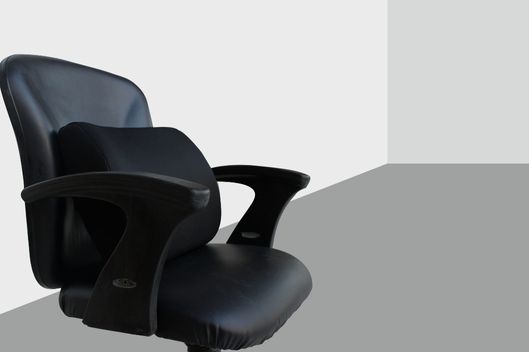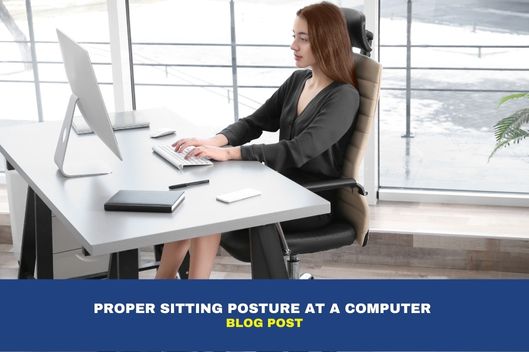Warehouse Clearance Sale – Limited time only!
Proper Sitting Posture at A Computer
A proper sitting posture is vital for maintaining proper back health and blood circulation. Sitting with proper posture helps to reduce the risk of back problems, neck pain and other physical issues that can arise from prolonged sitting in an uncomfortable position. A proper sitting posture can help improve your focus and alertness, increase productivity, and even lift your mood. However, finding the right balance between comfortability and proper seating ergonomics can sometimes take work. So, let’s get started!

This article will discuss the importance of proper posture when seated at a desk or computer for extended periods and tips on maintaining good posture while working to maximise efficiency and minimise potential health risks associated with lousy posture.
How Do You Get Into the Proper Sitting Position?
Begin by taking a seat at the far end of your chair. Slouch forward by rolling your shoulders and neck forward. Then, gradually raise your head and shoulders to an elevated sitting position. Press your lower back forward to emphasise your spine’s curvature. Hold for several seconds, even if it feels forced and painful.
Following these few basic steps can help you find the best seating position. Repeat these steps each time you sit down to help your body reach its optimal position. The following are the different factors that need to be considered to achieve a proper sitting posture at a computer:
1. Maintain Back Support
Ergonomic desk chairs are designed to correctly support your body while sitting, reducing stress and friction on bones and muscles. These seats are pricey, costing more than $100. Don’t worry if you aren’t ready to make that investment. You can try a variety of alternative options.
Roll up a small towel if your office chair lacks lumbar support. A tiny pillow can also suffice. After you’ve found your perfect posture, slide back in your chair and insert a towel or pillow between the chair and your lower back. This support item should assist you in maintaining proper posture. If the towel or pillow is overly large, you may force your spine into an unnatural position that quickly becomes painful.
2. Adjust Your Seat
Adjust the height of your seat so that your legs are level with the floor and your knees are even with your hips. Your arms should be lying parallel to the ground as well.
Your feet should be flat on the ground. If they aren’t, use a stool or footrest to elevate your feet until they are. Put both elbows at your sides while creating an L-shape with your arms. Arms far from your torso may strain your arms and shoulder muscles.

3. Place Your Feet on the Ground
Make sure your body weight is evenly distributed across your hips. Bend your knees at a straight angle, and make sure your knees are even with or slightly below your hips. Adjustable ergonomic footrests will allow you to choose the ideal angle of tilt and height for your natural posture alignment. Taking heels off may be the most comfortable option if you’re wearing them. Sit without crossing your legs; this can limit blood flow and strain muscles.
4. Maintain Eye Level With Your Screen
Next, change the monitor’s height. The top of your computer screen should be no higher than 2 inches above eye level. Too-low or too-high computer monitors can cause neck and eye pain.
A monitor desk stand is an essential item that can help if you want something more formal. A stack of books can be used to adjust the height of your monitor easily. But free-standing monitor mounts, such as the Executive Monitor Arm – Single, provide more adjustment options. The arms allow you to modify the height and tilt of the screen.

5. Keep Regularly Used Items Close At Hand
Excessive muscle tension can cause joint pain and other difficulties. Commonly used objects must be within easy reach to maintain appropriate posture while sitting at a desk and using a computer. Instead of stretching to get a stapler, phone, or notepad, keep things nearby so you may readily access them without straining your muscles.
6. Take Frequent Breaks
Long periods of sitting will limit blood flow and create muscle weariness. Take frequent breaks to avoid this. Get up from your desk and move about.
Calf lifts and shoulder shrugs will get your circulation flowing. Do some lunges or squats if you have enough room. Stand up and walk away from your desk when you take a break. Get up and move about every hour at the very least. Every 30 minutes, take a one- to two-minute break. Many short breaks during the day are preferable to a few long breaks.
In Conclusion
The modern office inhibits activity, and sitting all day can harm your health. Even so, correcting your posture can help you improve your health significantly. Investing in a few ergonomically designed goods and learning to sit correctly can go a long way toward decreasing muscle and bone wear and tear. These tips can pay off throughout your career as you avoid injuries, strains, and pain.
Direct Office Furniture understands that comfort and ergonomics are crucial to creating a productive and healthy workspace. That’s why we offer a variety of ergonomically designed furniture suitable for any office workspace! But choosing the right furniture is just one part of the equation. To ensure that your workspace is optimised for productivity and comfort, we also offer a free space planning and consultation service to help you create the perfect office setup that meets your needs and preferences.
If you’re looking to upgrade your workspace and create a healthy, productive environment, come visit us today and browse our selection of ergonomically designed furniture. And don’t forget to take advantage of our free space planning and consultation service to ensure that your workspace is optimised for success. Contact us today to learn more about our services and how we can help you create the perfect office setup.
